Report: Electromagnetic Braking System for Plug-in Hybrid Vehicles
VerifiedAdded on 2022/06/01
|18
|4641
|55
Report
AI Summary
This report provides a comprehensive analysis of electromagnetic braking systems and their application in plug-in hybrid electric vehicles (PHEVs). It begins with an executive summary highlighting the benefits of electromagnetic brakes over traditional friction-based systems, including improved durability and efficiency. The introduction emphasizes the growing interest in alternative vehicle technologies due to environmental, economic, and political factors, particularly the need to reduce greenhouse gas emissions from the transportation sector. A literature review explores the principles of electromagnetism, including Faraday’s Law and Lenz’s Law, and details the components and operation of electromagnetic braking systems. The report also covers the advantages of PHEVs, such as regenerative braking and reduced emissions, and compares them to conventional vehicles. The report then details the methodology used in the research, including project planning and a Gantt chart. It also addresses ethical considerations and risk management associated with the project. Finally, the report concludes by summarizing the key findings and emphasizing the potential of electromagnetic braking systems to enhance the performance and sustainability of hybrid electric vehicles.
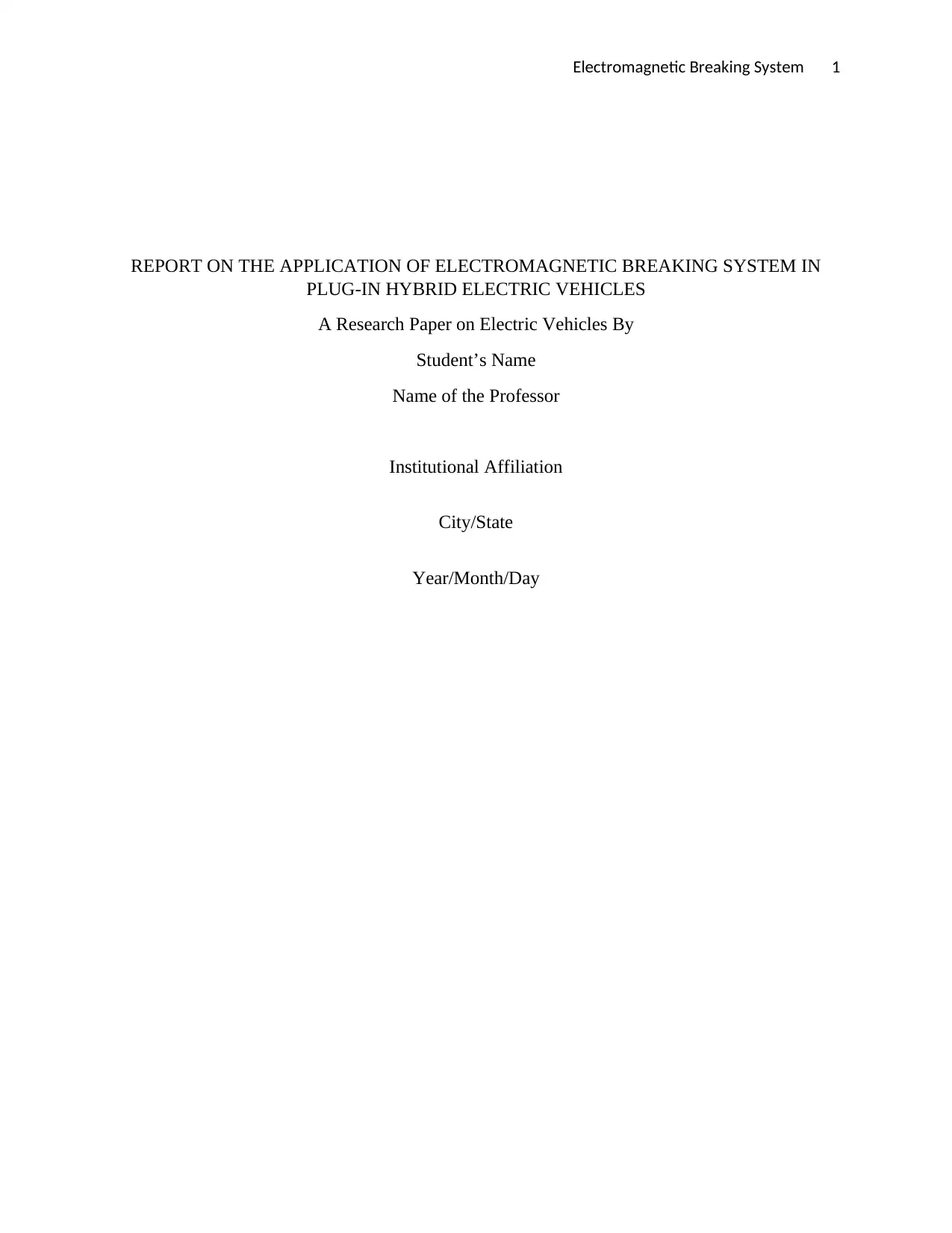
Electromagnetic Breaking System 1
REPORT ON THE APPLICATION OF ELECTROMAGNETIC BREAKING SYSTEM IN
PLUG-IN HYBRID ELECTRIC VEHICLES
A Research Paper on Electric Vehicles By
Student’s Name
Name of the Professor
Institutional Affiliation
City/State
Year/Month/Day
REPORT ON THE APPLICATION OF ELECTROMAGNETIC BREAKING SYSTEM IN
PLUG-IN HYBRID ELECTRIC VEHICLES
A Research Paper on Electric Vehicles By
Student’s Name
Name of the Professor
Institutional Affiliation
City/State
Year/Month/Day
Paraphrase This Document
Need a fresh take? Get an instant paraphrase of this document with our AI Paraphraser
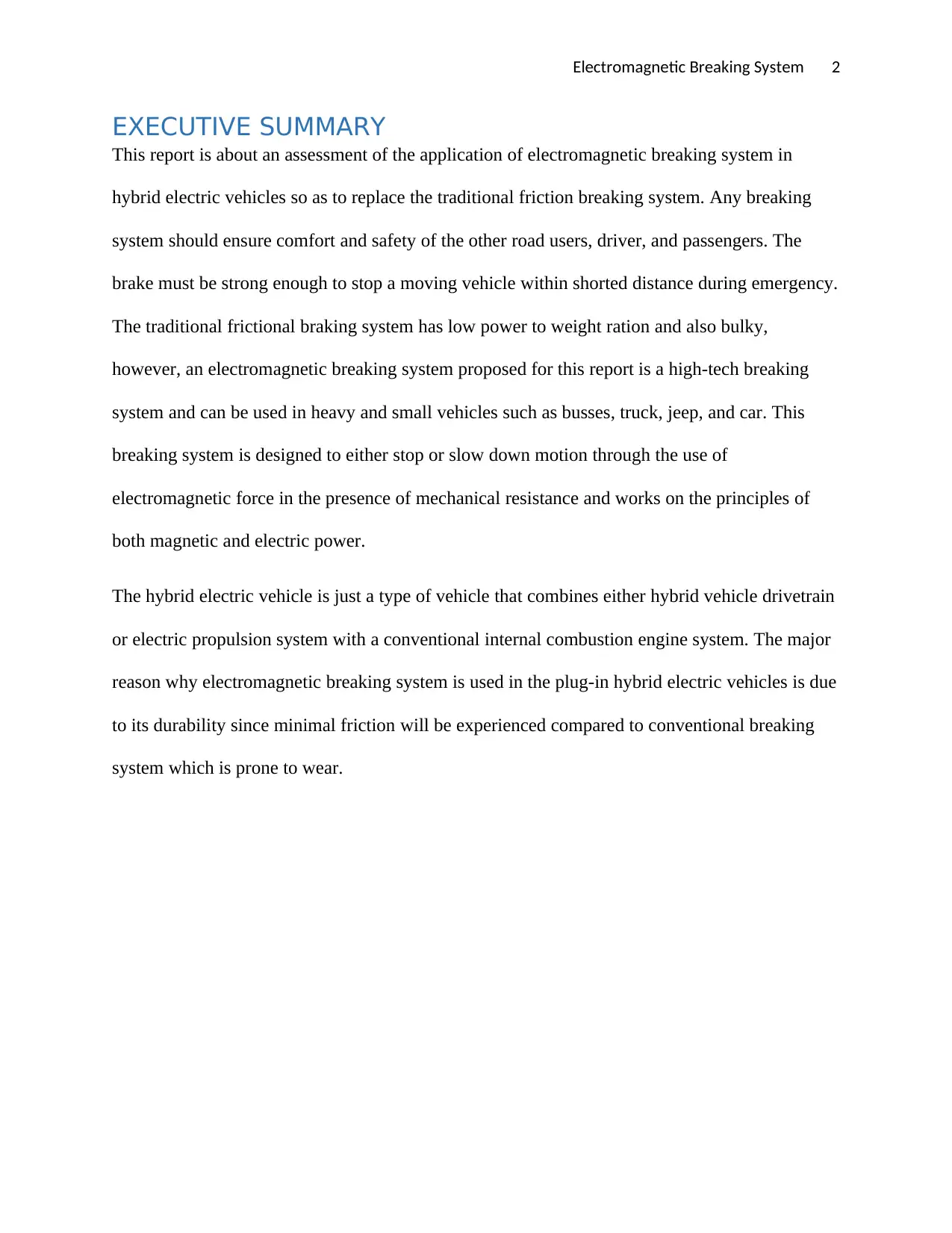
Electromagnetic Breaking System 2
EXECUTIVE SUMMARY
This report is about an assessment of the application of electromagnetic breaking system in
hybrid electric vehicles so as to replace the traditional friction breaking system. Any breaking
system should ensure comfort and safety of the other road users, driver, and passengers. The
brake must be strong enough to stop a moving vehicle within shorted distance during emergency.
The traditional frictional braking system has low power to weight ration and also bulky,
however, an electromagnetic breaking system proposed for this report is a high-tech breaking
system and can be used in heavy and small vehicles such as busses, truck, jeep, and car. This
breaking system is designed to either stop or slow down motion through the use of
electromagnetic force in the presence of mechanical resistance and works on the principles of
both magnetic and electric power.
The hybrid electric vehicle is just a type of vehicle that combines either hybrid vehicle drivetrain
or electric propulsion system with a conventional internal combustion engine system. The major
reason why electromagnetic breaking system is used in the plug-in hybrid electric vehicles is due
to its durability since minimal friction will be experienced compared to conventional breaking
system which is prone to wear.
EXECUTIVE SUMMARY
This report is about an assessment of the application of electromagnetic breaking system in
hybrid electric vehicles so as to replace the traditional friction breaking system. Any breaking
system should ensure comfort and safety of the other road users, driver, and passengers. The
brake must be strong enough to stop a moving vehicle within shorted distance during emergency.
The traditional frictional braking system has low power to weight ration and also bulky,
however, an electromagnetic breaking system proposed for this report is a high-tech breaking
system and can be used in heavy and small vehicles such as busses, truck, jeep, and car. This
breaking system is designed to either stop or slow down motion through the use of
electromagnetic force in the presence of mechanical resistance and works on the principles of
both magnetic and electric power.
The hybrid electric vehicle is just a type of vehicle that combines either hybrid vehicle drivetrain
or electric propulsion system with a conventional internal combustion engine system. The major
reason why electromagnetic breaking system is used in the plug-in hybrid electric vehicles is due
to its durability since minimal friction will be experienced compared to conventional breaking
system which is prone to wear.

Electromagnetic Breaking System 3
Table of Contents
EXECUTIVE SUMMARY.................................................................................................................................2
INTRODUCTION...........................................................................................................................................4
LITERATURE REVIEW....................................................................................................................................7
Principles of Electromagnetism...............................................................................................................7
Electromagnetic Break System................................................................................................................8
Electromagnetic Braking System Parts....................................................................................................9
Aims and sub goals................................................................................................................................11
Research questions................................................................................................................................12
METHODOLOGY.........................................................................................................................................12
PROJECT PLANNING AND GANTT CHART...................................................................................................14
Gantt chart............................................................................................................................................15
ETHICS.......................................................................................................................................................15
RISK MANAGEMENT..................................................................................................................................16
CONCLUSION.............................................................................................................................................16
BIBLIOGRAPHY...........................................................................................................................................17
Table of Contents
EXECUTIVE SUMMARY.................................................................................................................................2
INTRODUCTION...........................................................................................................................................4
LITERATURE REVIEW....................................................................................................................................7
Principles of Electromagnetism...............................................................................................................7
Electromagnetic Break System................................................................................................................8
Electromagnetic Braking System Parts....................................................................................................9
Aims and sub goals................................................................................................................................11
Research questions................................................................................................................................12
METHODOLOGY.........................................................................................................................................12
PROJECT PLANNING AND GANTT CHART...................................................................................................14
Gantt chart............................................................................................................................................15
ETHICS.......................................................................................................................................................15
RISK MANAGEMENT..................................................................................................................................16
CONCLUSION.............................................................................................................................................16
BIBLIOGRAPHY...........................................................................................................................................17
⊘ This is a preview!⊘
Do you want full access?
Subscribe today to unlock all pages.

Trusted by 1+ million students worldwide
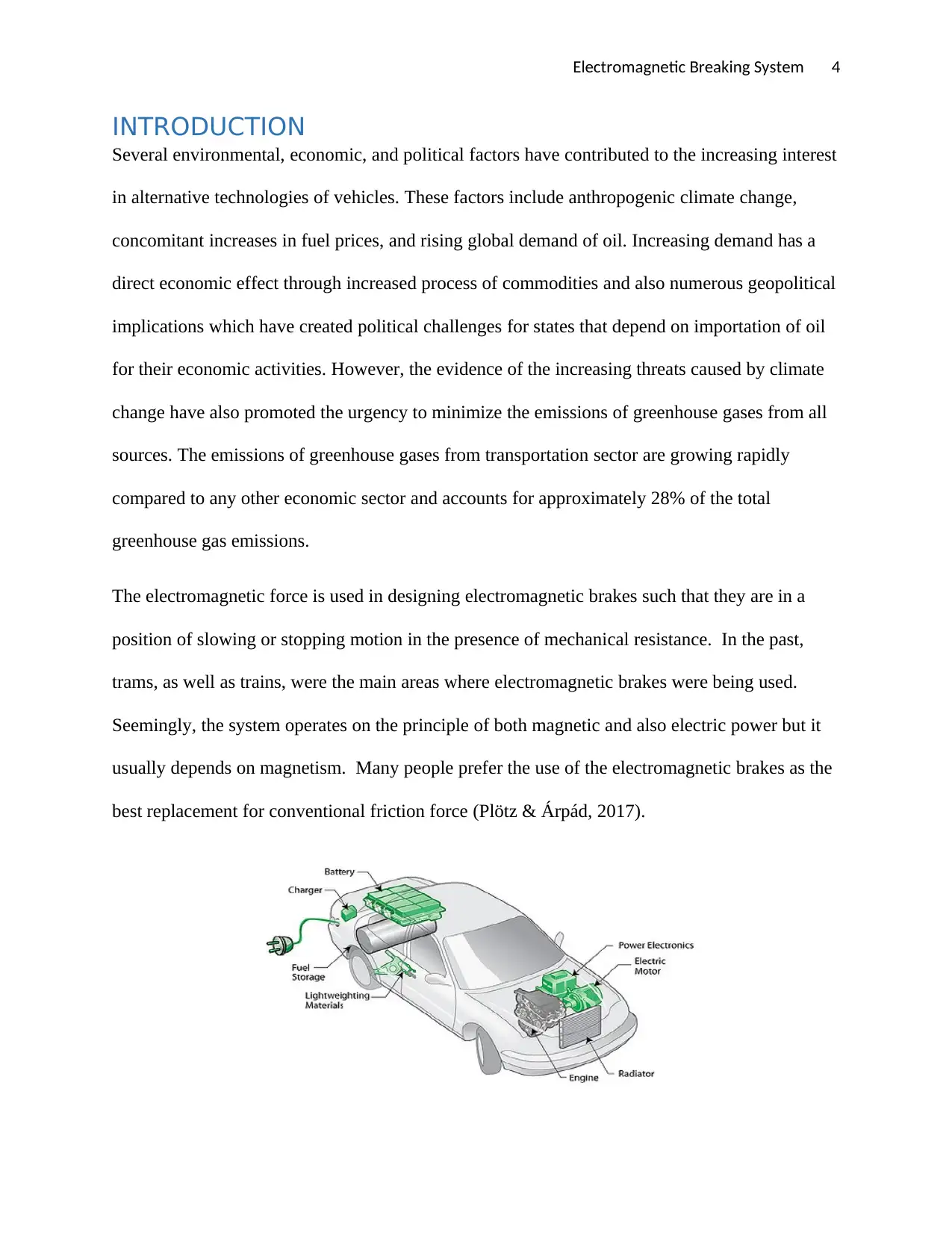
Electromagnetic Breaking System 4
INTRODUCTION
Several environmental, economic, and political factors have contributed to the increasing interest
in alternative technologies of vehicles. These factors include anthropogenic climate change,
concomitant increases in fuel prices, and rising global demand of oil. Increasing demand has a
direct economic effect through increased process of commodities and also numerous geopolitical
implications which have created political challenges for states that depend on importation of oil
for their economic activities. However, the evidence of the increasing threats caused by climate
change have also promoted the urgency to minimize the emissions of greenhouse gases from all
sources. The emissions of greenhouse gases from transportation sector are growing rapidly
compared to any other economic sector and accounts for approximately 28% of the total
greenhouse gas emissions.
The electromagnetic force is used in designing electromagnetic brakes such that they are in a
position of slowing or stopping motion in the presence of mechanical resistance. In the past,
trams, as well as trains, were the main areas where electromagnetic brakes were being used.
Seemingly, the system operates on the principle of both magnetic and also electric power but it
usually depends on magnetism. Many people prefer the use of the electromagnetic brakes as the
best replacement for conventional friction force (Plötz & Árpád, 2017).
INTRODUCTION
Several environmental, economic, and political factors have contributed to the increasing interest
in alternative technologies of vehicles. These factors include anthropogenic climate change,
concomitant increases in fuel prices, and rising global demand of oil. Increasing demand has a
direct economic effect through increased process of commodities and also numerous geopolitical
implications which have created political challenges for states that depend on importation of oil
for their economic activities. However, the evidence of the increasing threats caused by climate
change have also promoted the urgency to minimize the emissions of greenhouse gases from all
sources. The emissions of greenhouse gases from transportation sector are growing rapidly
compared to any other economic sector and accounts for approximately 28% of the total
greenhouse gas emissions.
The electromagnetic force is used in designing electromagnetic brakes such that they are in a
position of slowing or stopping motion in the presence of mechanical resistance. In the past,
trams, as well as trains, were the main areas where electromagnetic brakes were being used.
Seemingly, the system operates on the principle of both magnetic and also electric power but it
usually depends on magnetism. Many people prefer the use of the electromagnetic brakes as the
best replacement for conventional friction force (Plötz & Árpád, 2017).
Paraphrase This Document
Need a fresh take? Get an instant paraphrase of this document with our AI Paraphraser
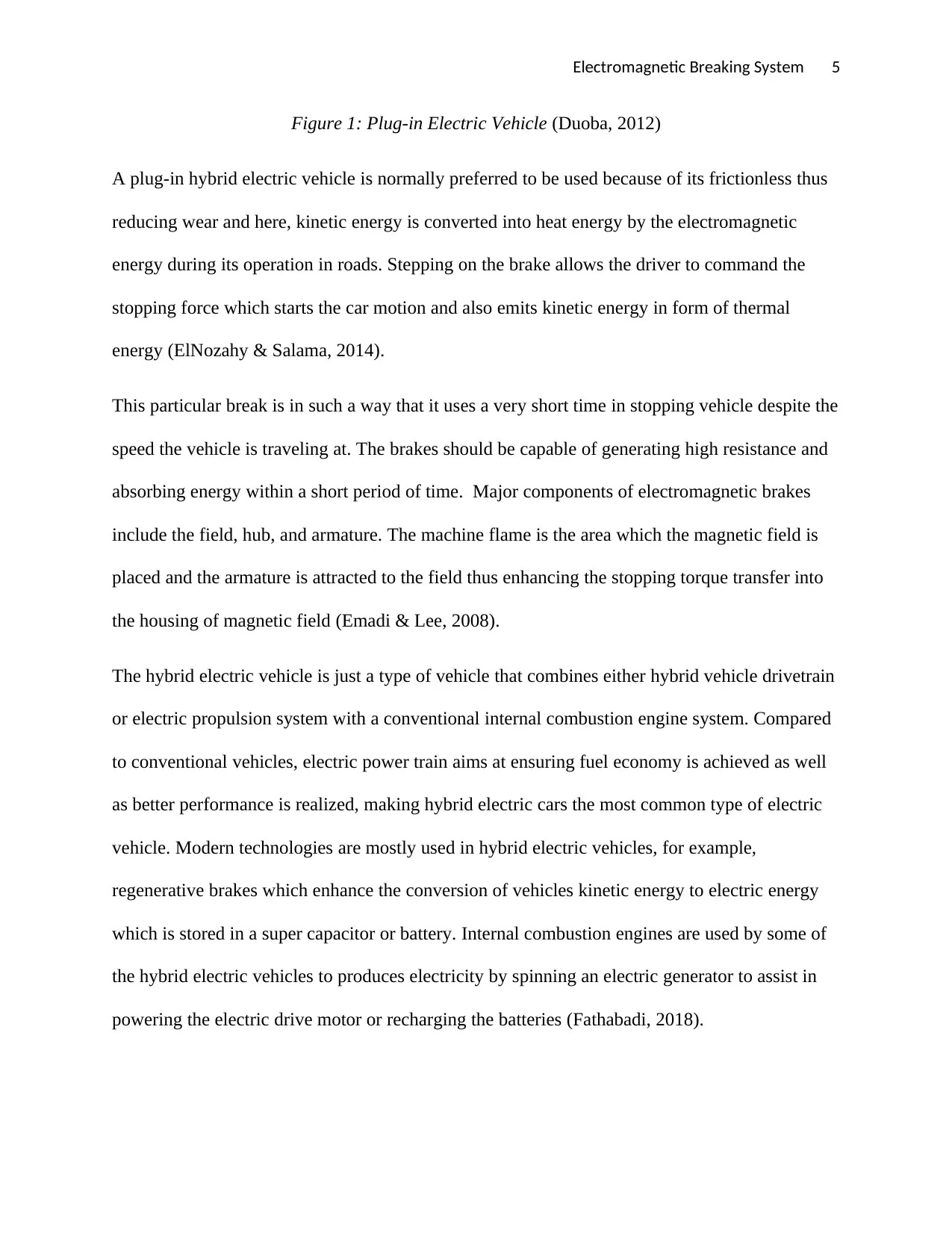
Electromagnetic Breaking System 5
Figure 1: Plug-in Electric Vehicle (Duoba, 2012)
A plug-in hybrid electric vehicle is normally preferred to be used because of its frictionless thus
reducing wear and here, kinetic energy is converted into heat energy by the electromagnetic
energy during its operation in roads. Stepping on the brake allows the driver to command the
stopping force which starts the car motion and also emits kinetic energy in form of thermal
energy (ElNozahy & Salama, 2014).
This particular break is in such a way that it uses a very short time in stopping vehicle despite the
speed the vehicle is traveling at. The brakes should be capable of generating high resistance and
absorbing energy within a short period of time. Major components of electromagnetic brakes
include the field, hub, and armature. The machine flame is the area which the magnetic field is
placed and the armature is attracted to the field thus enhancing the stopping torque transfer into
the housing of magnetic field (Emadi & Lee, 2008).
The hybrid electric vehicle is just a type of vehicle that combines either hybrid vehicle drivetrain
or electric propulsion system with a conventional internal combustion engine system. Compared
to conventional vehicles, electric power train aims at ensuring fuel economy is achieved as well
as better performance is realized, making hybrid electric cars the most common type of electric
vehicle. Modern technologies are mostly used in hybrid electric vehicles, for example,
regenerative brakes which enhance the conversion of vehicles kinetic energy to electric energy
which is stored in a super capacitor or battery. Internal combustion engines are used by some of
the hybrid electric vehicles to produces electricity by spinning an electric generator to assist in
powering the electric drive motor or recharging the batteries (Fathabadi, 2018).
Figure 1: Plug-in Electric Vehicle (Duoba, 2012)
A plug-in hybrid electric vehicle is normally preferred to be used because of its frictionless thus
reducing wear and here, kinetic energy is converted into heat energy by the electromagnetic
energy during its operation in roads. Stepping on the brake allows the driver to command the
stopping force which starts the car motion and also emits kinetic energy in form of thermal
energy (ElNozahy & Salama, 2014).
This particular break is in such a way that it uses a very short time in stopping vehicle despite the
speed the vehicle is traveling at. The brakes should be capable of generating high resistance and
absorbing energy within a short period of time. Major components of electromagnetic brakes
include the field, hub, and armature. The machine flame is the area which the magnetic field is
placed and the armature is attracted to the field thus enhancing the stopping torque transfer into
the housing of magnetic field (Emadi & Lee, 2008).
The hybrid electric vehicle is just a type of vehicle that combines either hybrid vehicle drivetrain
or electric propulsion system with a conventional internal combustion engine system. Compared
to conventional vehicles, electric power train aims at ensuring fuel economy is achieved as well
as better performance is realized, making hybrid electric cars the most common type of electric
vehicle. Modern technologies are mostly used in hybrid electric vehicles, for example,
regenerative brakes which enhance the conversion of vehicles kinetic energy to electric energy
which is stored in a super capacitor or battery. Internal combustion engines are used by some of
the hybrid electric vehicles to produces electricity by spinning an electric generator to assist in
powering the electric drive motor or recharging the batteries (Fathabadi, 2018).
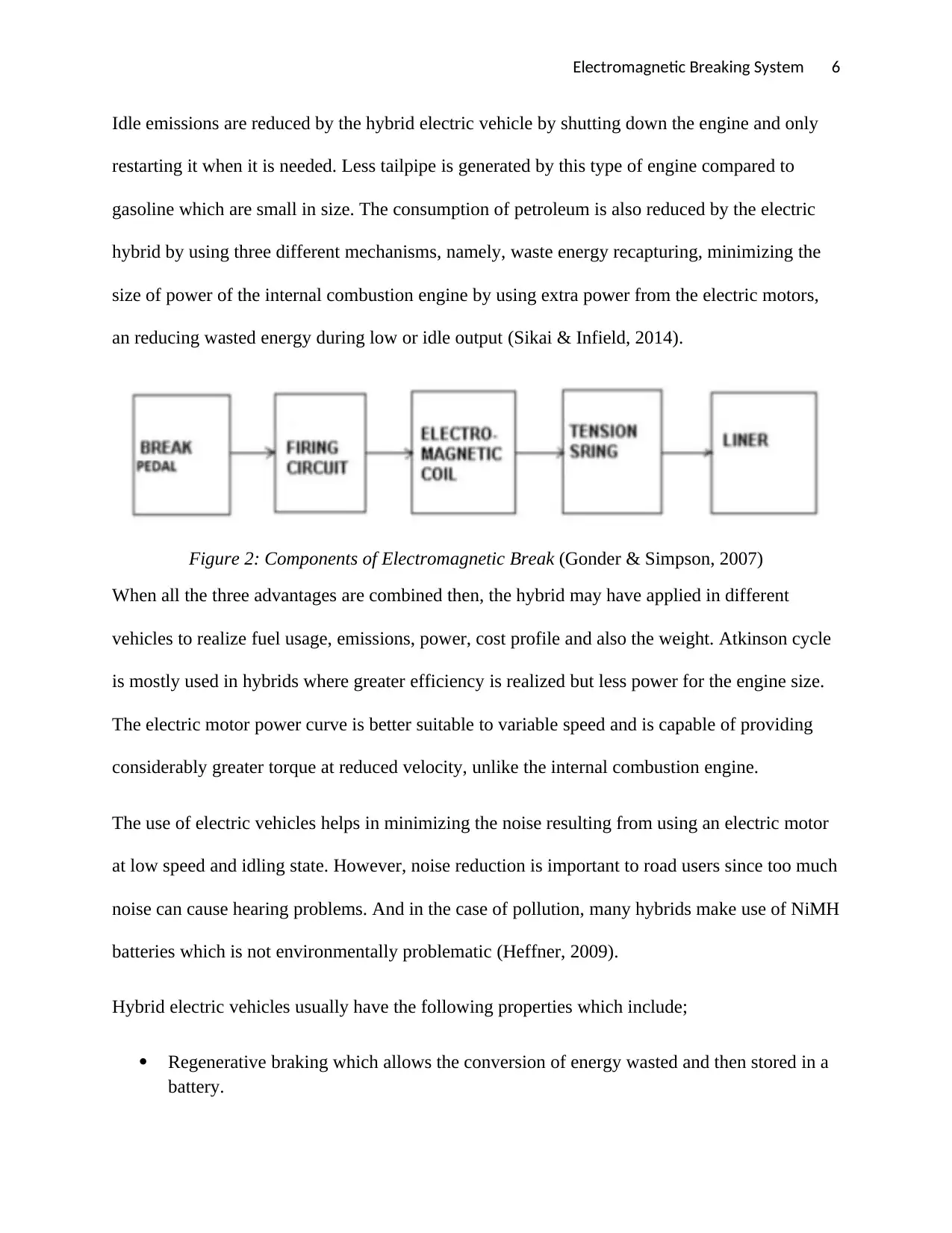
Electromagnetic Breaking System 6
Idle emissions are reduced by the hybrid electric vehicle by shutting down the engine and only
restarting it when it is needed. Less tailpipe is generated by this type of engine compared to
gasoline which are small in size. The consumption of petroleum is also reduced by the electric
hybrid by using three different mechanisms, namely, waste energy recapturing, minimizing the
size of power of the internal combustion engine by using extra power from the electric motors,
an reducing wasted energy during low or idle output (Sikai & Infield, 2014).
Figure 2: Components of Electromagnetic Break (Gonder & Simpson, 2007)
When all the three advantages are combined then, the hybrid may have applied in different
vehicles to realize fuel usage, emissions, power, cost profile and also the weight. Atkinson cycle
is mostly used in hybrids where greater efficiency is realized but less power for the engine size.
The electric motor power curve is better suitable to variable speed and is capable of providing
considerably greater torque at reduced velocity, unlike the internal combustion engine.
The use of electric vehicles helps in minimizing the noise resulting from using an electric motor
at low speed and idling state. However, noise reduction is important to road users since too much
noise can cause hearing problems. And in the case of pollution, many hybrids make use of NiMH
batteries which is not environmentally problematic (Heffner, 2009).
Hybrid electric vehicles usually have the following properties which include;
Regenerative braking which allows the conversion of energy wasted and then stored in a
battery.
Idle emissions are reduced by the hybrid electric vehicle by shutting down the engine and only
restarting it when it is needed. Less tailpipe is generated by this type of engine compared to
gasoline which are small in size. The consumption of petroleum is also reduced by the electric
hybrid by using three different mechanisms, namely, waste energy recapturing, minimizing the
size of power of the internal combustion engine by using extra power from the electric motors,
an reducing wasted energy during low or idle output (Sikai & Infield, 2014).
Figure 2: Components of Electromagnetic Break (Gonder & Simpson, 2007)
When all the three advantages are combined then, the hybrid may have applied in different
vehicles to realize fuel usage, emissions, power, cost profile and also the weight. Atkinson cycle
is mostly used in hybrids where greater efficiency is realized but less power for the engine size.
The electric motor power curve is better suitable to variable speed and is capable of providing
considerably greater torque at reduced velocity, unlike the internal combustion engine.
The use of electric vehicles helps in minimizing the noise resulting from using an electric motor
at low speed and idling state. However, noise reduction is important to road users since too much
noise can cause hearing problems. And in the case of pollution, many hybrids make use of NiMH
batteries which is not environmentally problematic (Heffner, 2009).
Hybrid electric vehicles usually have the following properties which include;
Regenerative braking which allows the conversion of energy wasted and then stored in a
battery.
⊘ This is a preview!⊘
Do you want full access?
Subscribe today to unlock all pages.

Trusted by 1+ million students worldwide
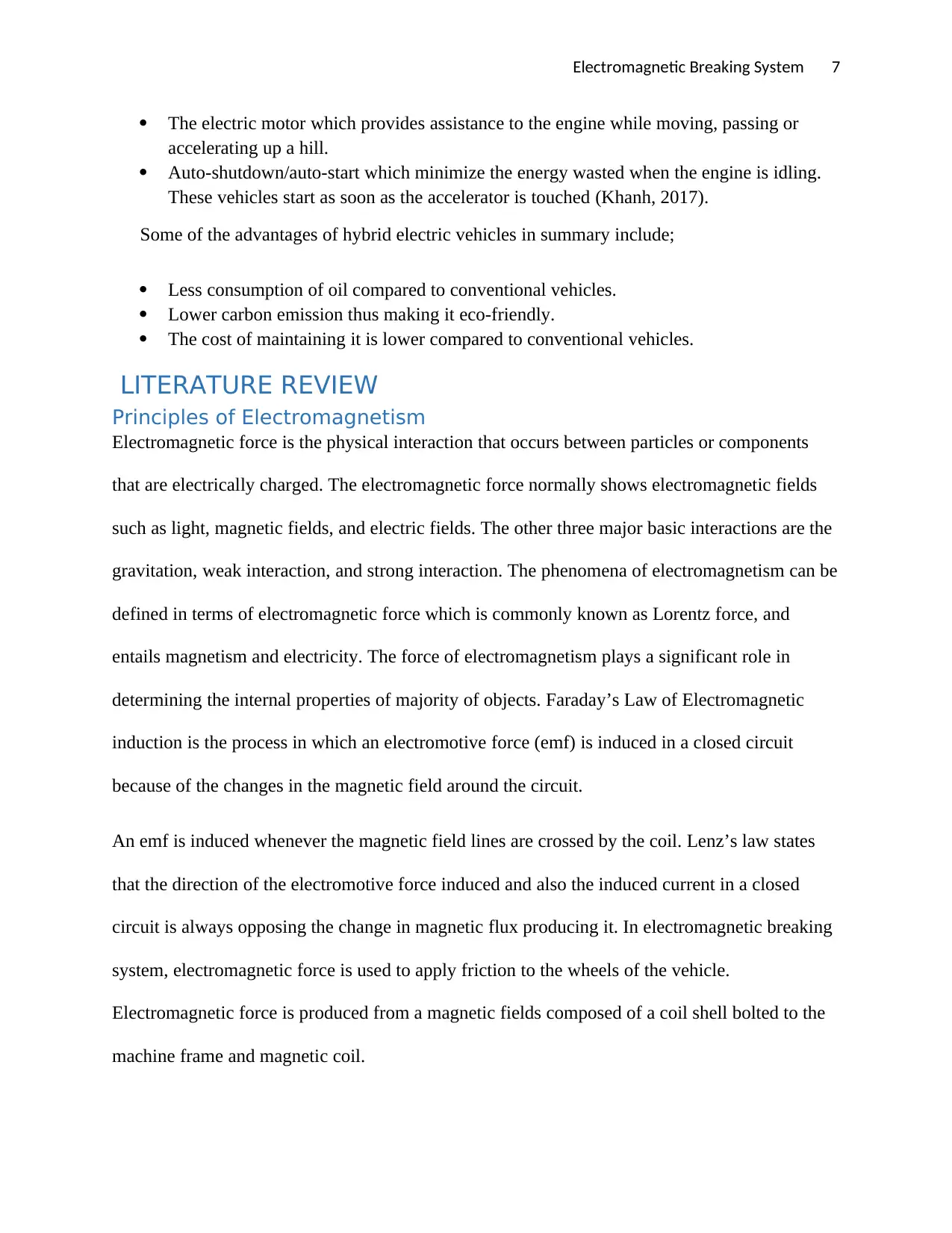
Electromagnetic Breaking System 7
The electric motor which provides assistance to the engine while moving, passing or
accelerating up a hill.
Auto-shutdown/auto-start which minimize the energy wasted when the engine is idling.
These vehicles start as soon as the accelerator is touched (Khanh, 2017).
Some of the advantages of hybrid electric vehicles in summary include;
Less consumption of oil compared to conventional vehicles.
Lower carbon emission thus making it eco-friendly.
The cost of maintaining it is lower compared to conventional vehicles.
LITERATURE REVIEW
Principles of Electromagnetism
Electromagnetic force is the physical interaction that occurs between particles or components
that are electrically charged. The electromagnetic force normally shows electromagnetic fields
such as light, magnetic fields, and electric fields. The other three major basic interactions are the
gravitation, weak interaction, and strong interaction. The phenomena of electromagnetism can be
defined in terms of electromagnetic force which is commonly known as Lorentz force, and
entails magnetism and electricity. The force of electromagnetism plays a significant role in
determining the internal properties of majority of objects. Faraday’s Law of Electromagnetic
induction is the process in which an electromotive force (emf) is induced in a closed circuit
because of the changes in the magnetic field around the circuit.
An emf is induced whenever the magnetic field lines are crossed by the coil. Lenz’s law states
that the direction of the electromotive force induced and also the induced current in a closed
circuit is always opposing the change in magnetic flux producing it. In electromagnetic breaking
system, electromagnetic force is used to apply friction to the wheels of the vehicle.
Electromagnetic force is produced from a magnetic fields composed of a coil shell bolted to the
machine frame and magnetic coil.
The electric motor which provides assistance to the engine while moving, passing or
accelerating up a hill.
Auto-shutdown/auto-start which minimize the energy wasted when the engine is idling.
These vehicles start as soon as the accelerator is touched (Khanh, 2017).
Some of the advantages of hybrid electric vehicles in summary include;
Less consumption of oil compared to conventional vehicles.
Lower carbon emission thus making it eco-friendly.
The cost of maintaining it is lower compared to conventional vehicles.
LITERATURE REVIEW
Principles of Electromagnetism
Electromagnetic force is the physical interaction that occurs between particles or components
that are electrically charged. The electromagnetic force normally shows electromagnetic fields
such as light, magnetic fields, and electric fields. The other three major basic interactions are the
gravitation, weak interaction, and strong interaction. The phenomena of electromagnetism can be
defined in terms of electromagnetic force which is commonly known as Lorentz force, and
entails magnetism and electricity. The force of electromagnetism plays a significant role in
determining the internal properties of majority of objects. Faraday’s Law of Electromagnetic
induction is the process in which an electromotive force (emf) is induced in a closed circuit
because of the changes in the magnetic field around the circuit.
An emf is induced whenever the magnetic field lines are crossed by the coil. Lenz’s law states
that the direction of the electromotive force induced and also the induced current in a closed
circuit is always opposing the change in magnetic flux producing it. In electromagnetic breaking
system, electromagnetic force is used to apply friction to the wheels of the vehicle.
Electromagnetic force is produced from a magnetic fields composed of a coil shell bolted to the
machine frame and magnetic coil.
Paraphrase This Document
Need a fresh take? Get an instant paraphrase of this document with our AI Paraphraser
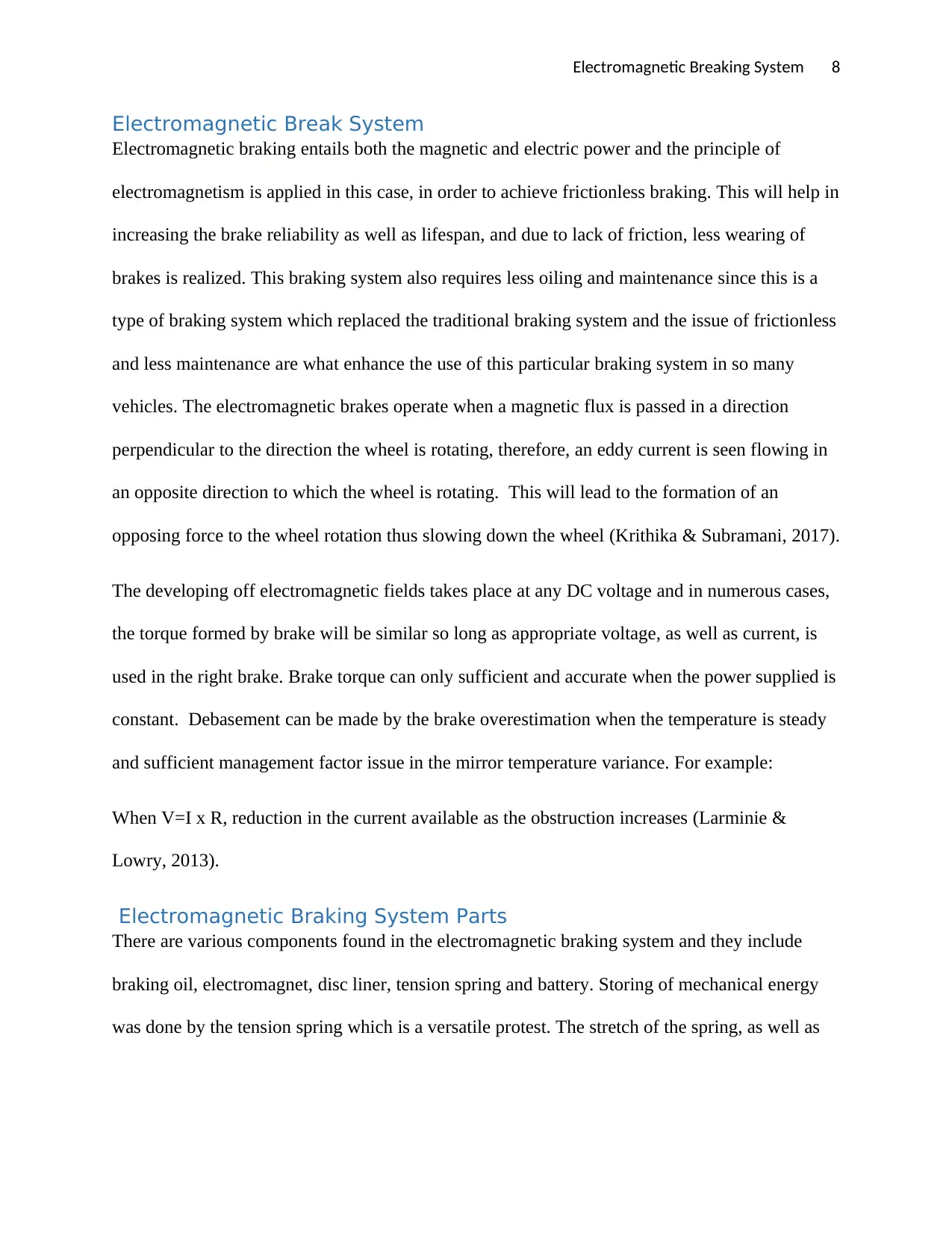
Electromagnetic Breaking System 8
Electromagnetic Break System
Electromagnetic braking entails both the magnetic and electric power and the principle of
electromagnetism is applied in this case, in order to achieve frictionless braking. This will help in
increasing the brake reliability as well as lifespan, and due to lack of friction, less wearing of
brakes is realized. This braking system also requires less oiling and maintenance since this is a
type of braking system which replaced the traditional braking system and the issue of frictionless
and less maintenance are what enhance the use of this particular braking system in so many
vehicles. The electromagnetic brakes operate when a magnetic flux is passed in a direction
perpendicular to the direction the wheel is rotating, therefore, an eddy current is seen flowing in
an opposite direction to which the wheel is rotating. This will lead to the formation of an
opposing force to the wheel rotation thus slowing down the wheel (Krithika & Subramani, 2017).
The developing off electromagnetic fields takes place at any DC voltage and in numerous cases,
the torque formed by brake will be similar so long as appropriate voltage, as well as current, is
used in the right brake. Brake torque can only sufficient and accurate when the power supplied is
constant. Debasement can be made by the brake overestimation when the temperature is steady
and sufficient management factor issue in the mirror temperature variance. For example:
When V=I x R, reduction in the current available as the obstruction increases (Larminie &
Lowry, 2013).
Electromagnetic Braking System Parts
There are various components found in the electromagnetic braking system and they include
braking oil, electromagnet, disc liner, tension spring and battery. Storing of mechanical energy
was done by the tension spring which is a versatile protest. The stretch of the spring, as well as
Electromagnetic Break System
Electromagnetic braking entails both the magnetic and electric power and the principle of
electromagnetism is applied in this case, in order to achieve frictionless braking. This will help in
increasing the brake reliability as well as lifespan, and due to lack of friction, less wearing of
brakes is realized. This braking system also requires less oiling and maintenance since this is a
type of braking system which replaced the traditional braking system and the issue of frictionless
and less maintenance are what enhance the use of this particular braking system in so many
vehicles. The electromagnetic brakes operate when a magnetic flux is passed in a direction
perpendicular to the direction the wheel is rotating, therefore, an eddy current is seen flowing in
an opposite direction to which the wheel is rotating. This will lead to the formation of an
opposing force to the wheel rotation thus slowing down the wheel (Krithika & Subramani, 2017).
The developing off electromagnetic fields takes place at any DC voltage and in numerous cases,
the torque formed by brake will be similar so long as appropriate voltage, as well as current, is
used in the right brake. Brake torque can only sufficient and accurate when the power supplied is
constant. Debasement can be made by the brake overestimation when the temperature is steady
and sufficient management factor issue in the mirror temperature variance. For example:
When V=I x R, reduction in the current available as the obstruction increases (Larminie &
Lowry, 2013).
Electromagnetic Braking System Parts
There are various components found in the electromagnetic braking system and they include
braking oil, electromagnet, disc liner, tension spring and battery. Storing of mechanical energy
was done by the tension spring which is a versatile protest. The stretch of the spring, as well as
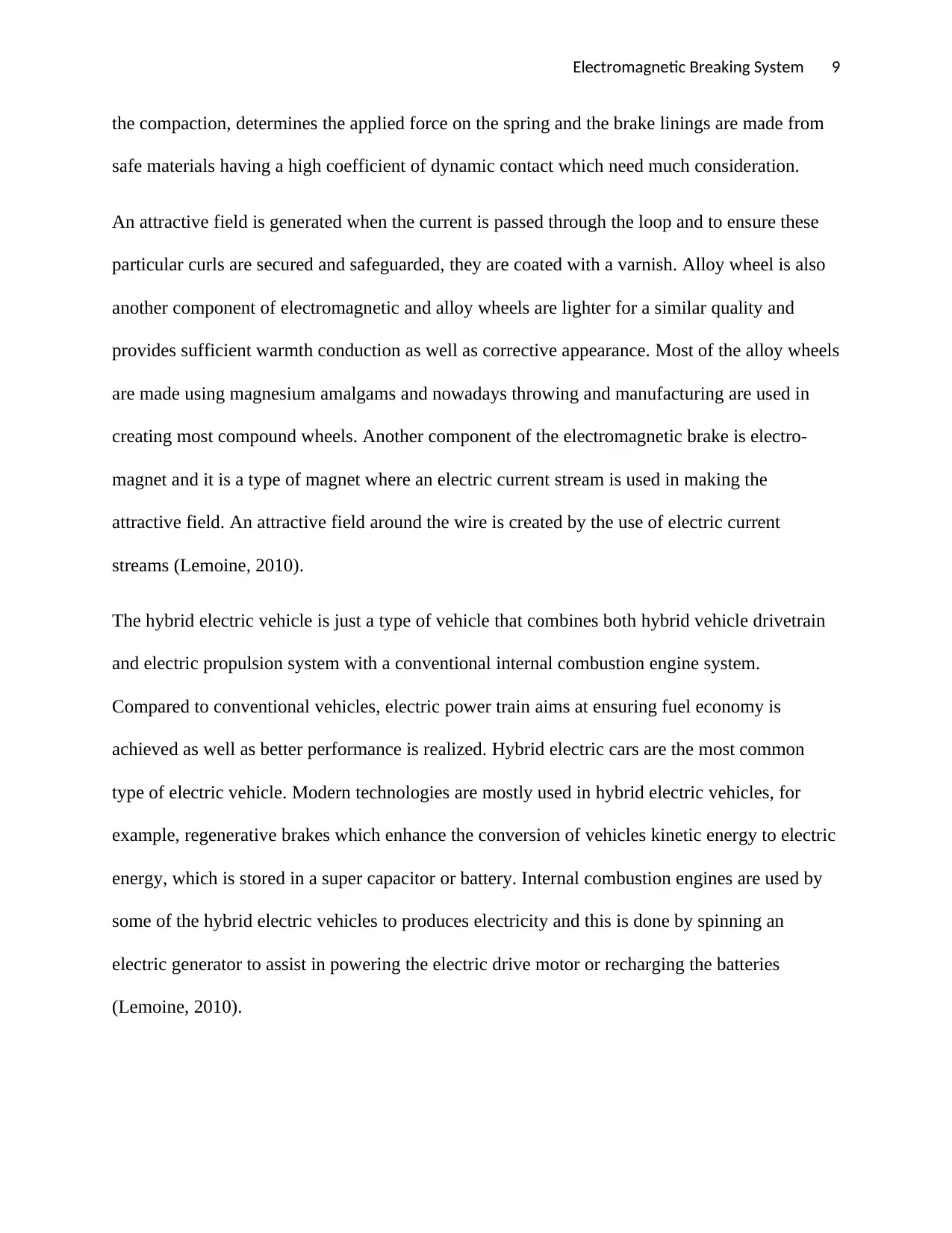
Electromagnetic Breaking System 9
the compaction, determines the applied force on the spring and the brake linings are made from
safe materials having a high coefficient of dynamic contact which need much consideration.
An attractive field is generated when the current is passed through the loop and to ensure these
particular curls are secured and safeguarded, they are coated with a varnish. Alloy wheel is also
another component of electromagnetic and alloy wheels are lighter for a similar quality and
provides sufficient warmth conduction as well as corrective appearance. Most of the alloy wheels
are made using magnesium amalgams and nowadays throwing and manufacturing are used in
creating most compound wheels. Another component of the electromagnetic brake is electro-
magnet and it is a type of magnet where an electric current stream is used in making the
attractive field. An attractive field around the wire is created by the use of electric current
streams (Lemoine, 2010).
The hybrid electric vehicle is just a type of vehicle that combines both hybrid vehicle drivetrain
and electric propulsion system with a conventional internal combustion engine system.
Compared to conventional vehicles, electric power train aims at ensuring fuel economy is
achieved as well as better performance is realized. Hybrid electric cars are the most common
type of electric vehicle. Modern technologies are mostly used in hybrid electric vehicles, for
example, regenerative brakes which enhance the conversion of vehicles kinetic energy to electric
energy, which is stored in a super capacitor or battery. Internal combustion engines are used by
some of the hybrid electric vehicles to produces electricity and this is done by spinning an
electric generator to assist in powering the electric drive motor or recharging the batteries
(Lemoine, 2010).
the compaction, determines the applied force on the spring and the brake linings are made from
safe materials having a high coefficient of dynamic contact which need much consideration.
An attractive field is generated when the current is passed through the loop and to ensure these
particular curls are secured and safeguarded, they are coated with a varnish. Alloy wheel is also
another component of electromagnetic and alloy wheels are lighter for a similar quality and
provides sufficient warmth conduction as well as corrective appearance. Most of the alloy wheels
are made using magnesium amalgams and nowadays throwing and manufacturing are used in
creating most compound wheels. Another component of the electromagnetic brake is electro-
magnet and it is a type of magnet where an electric current stream is used in making the
attractive field. An attractive field around the wire is created by the use of electric current
streams (Lemoine, 2010).
The hybrid electric vehicle is just a type of vehicle that combines both hybrid vehicle drivetrain
and electric propulsion system with a conventional internal combustion engine system.
Compared to conventional vehicles, electric power train aims at ensuring fuel economy is
achieved as well as better performance is realized. Hybrid electric cars are the most common
type of electric vehicle. Modern technologies are mostly used in hybrid electric vehicles, for
example, regenerative brakes which enhance the conversion of vehicles kinetic energy to electric
energy, which is stored in a super capacitor or battery. Internal combustion engines are used by
some of the hybrid electric vehicles to produces electricity and this is done by spinning an
electric generator to assist in powering the electric drive motor or recharging the batteries
(Lemoine, 2010).
⊘ This is a preview!⊘
Do you want full access?
Subscribe today to unlock all pages.

Trusted by 1+ million students worldwide
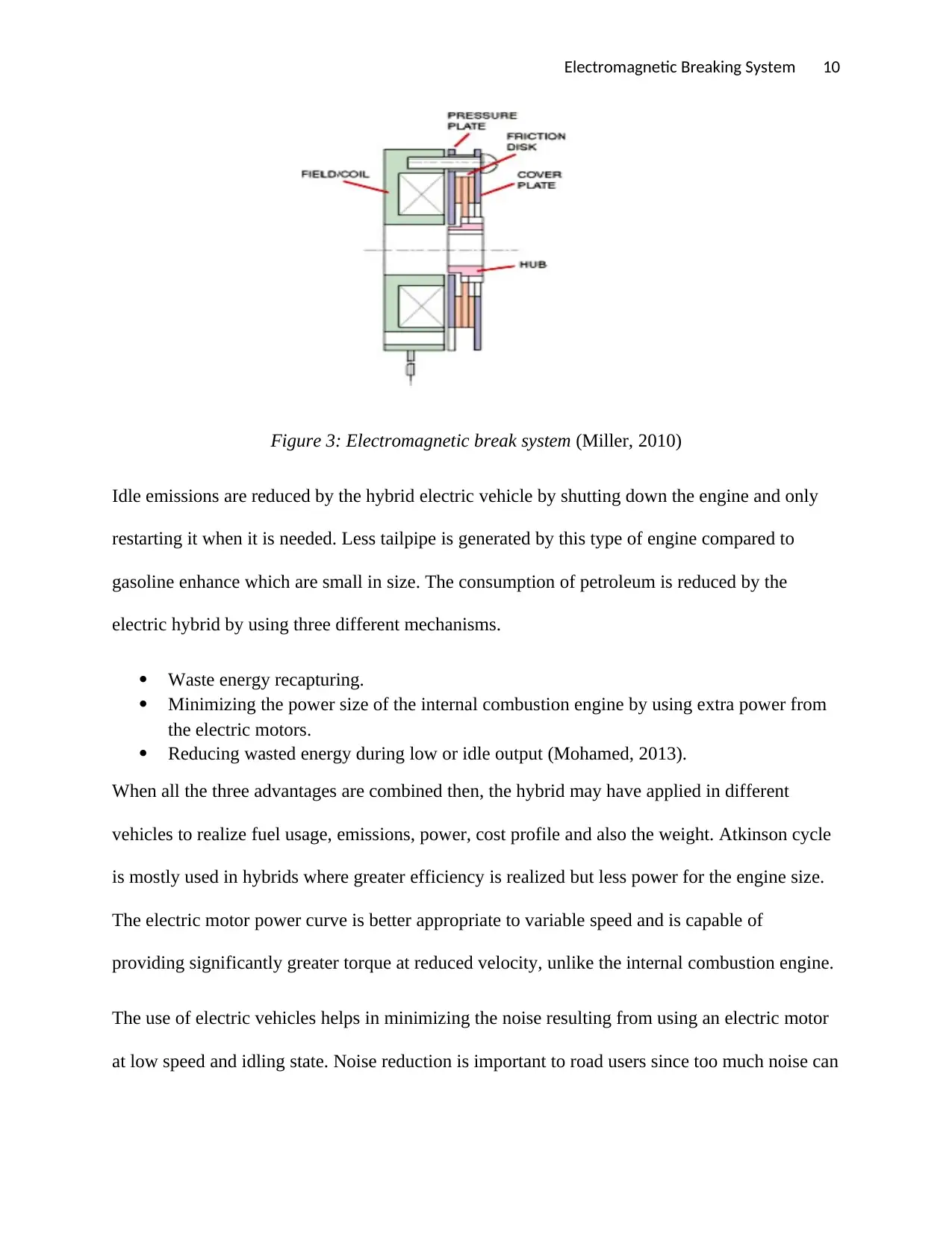
Electromagnetic Breaking System 10
Figure 3: Electromagnetic break system (Miller, 2010)
Idle emissions are reduced by the hybrid electric vehicle by shutting down the engine and only
restarting it when it is needed. Less tailpipe is generated by this type of engine compared to
gasoline enhance which are small in size. The consumption of petroleum is reduced by the
electric hybrid by using three different mechanisms.
Waste energy recapturing.
Minimizing the power size of the internal combustion engine by using extra power from
the electric motors.
Reducing wasted energy during low or idle output (Mohamed, 2013).
When all the three advantages are combined then, the hybrid may have applied in different
vehicles to realize fuel usage, emissions, power, cost profile and also the weight. Atkinson cycle
is mostly used in hybrids where greater efficiency is realized but less power for the engine size.
The electric motor power curve is better appropriate to variable speed and is capable of
providing significantly greater torque at reduced velocity, unlike the internal combustion engine.
The use of electric vehicles helps in minimizing the noise resulting from using an electric motor
at low speed and idling state. Noise reduction is important to road users since too much noise can
Figure 3: Electromagnetic break system (Miller, 2010)
Idle emissions are reduced by the hybrid electric vehicle by shutting down the engine and only
restarting it when it is needed. Less tailpipe is generated by this type of engine compared to
gasoline enhance which are small in size. The consumption of petroleum is reduced by the
electric hybrid by using three different mechanisms.
Waste energy recapturing.
Minimizing the power size of the internal combustion engine by using extra power from
the electric motors.
Reducing wasted energy during low or idle output (Mohamed, 2013).
When all the three advantages are combined then, the hybrid may have applied in different
vehicles to realize fuel usage, emissions, power, cost profile and also the weight. Atkinson cycle
is mostly used in hybrids where greater efficiency is realized but less power for the engine size.
The electric motor power curve is better appropriate to variable speed and is capable of
providing significantly greater torque at reduced velocity, unlike the internal combustion engine.
The use of electric vehicles helps in minimizing the noise resulting from using an electric motor
at low speed and idling state. Noise reduction is important to road users since too much noise can
Paraphrase This Document
Need a fresh take? Get an instant paraphrase of this document with our AI Paraphraser
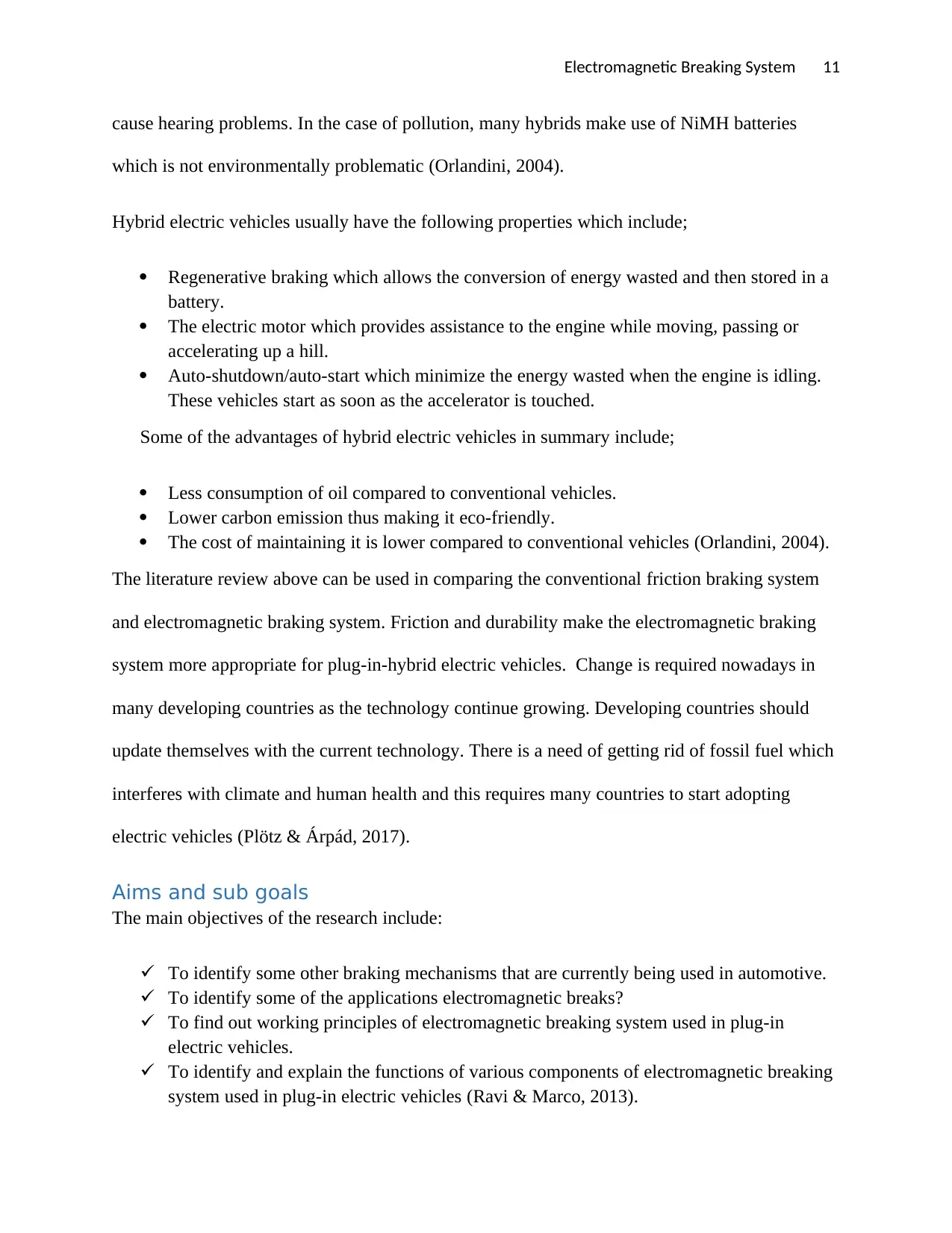
Electromagnetic Breaking System 11
cause hearing problems. In the case of pollution, many hybrids make use of NiMH batteries
which is not environmentally problematic (Orlandini, 2004).
Hybrid electric vehicles usually have the following properties which include;
Regenerative braking which allows the conversion of energy wasted and then stored in a
battery.
The electric motor which provides assistance to the engine while moving, passing or
accelerating up a hill.
Auto-shutdown/auto-start which minimize the energy wasted when the engine is idling.
These vehicles start as soon as the accelerator is touched.
Some of the advantages of hybrid electric vehicles in summary include;
Less consumption of oil compared to conventional vehicles.
Lower carbon emission thus making it eco-friendly.
The cost of maintaining it is lower compared to conventional vehicles (Orlandini, 2004).
The literature review above can be used in comparing the conventional friction braking system
and electromagnetic braking system. Friction and durability make the electromagnetic braking
system more appropriate for plug-in-hybrid electric vehicles. Change is required nowadays in
many developing countries as the technology continue growing. Developing countries should
update themselves with the current technology. There is a need of getting rid of fossil fuel which
interferes with climate and human health and this requires many countries to start adopting
electric vehicles (Plötz & Árpád, 2017).
Aims and sub goals
The main objectives of the research include:
To identify some other braking mechanisms that are currently being used in automotive.
To identify some of the applications electromagnetic breaks?
To find out working principles of electromagnetic breaking system used in plug-in
electric vehicles.
To identify and explain the functions of various components of electromagnetic breaking
system used in plug-in electric vehicles (Ravi & Marco, 2013).
cause hearing problems. In the case of pollution, many hybrids make use of NiMH batteries
which is not environmentally problematic (Orlandini, 2004).
Hybrid electric vehicles usually have the following properties which include;
Regenerative braking which allows the conversion of energy wasted and then stored in a
battery.
The electric motor which provides assistance to the engine while moving, passing or
accelerating up a hill.
Auto-shutdown/auto-start which minimize the energy wasted when the engine is idling.
These vehicles start as soon as the accelerator is touched.
Some of the advantages of hybrid electric vehicles in summary include;
Less consumption of oil compared to conventional vehicles.
Lower carbon emission thus making it eco-friendly.
The cost of maintaining it is lower compared to conventional vehicles (Orlandini, 2004).
The literature review above can be used in comparing the conventional friction braking system
and electromagnetic braking system. Friction and durability make the electromagnetic braking
system more appropriate for plug-in-hybrid electric vehicles. Change is required nowadays in
many developing countries as the technology continue growing. Developing countries should
update themselves with the current technology. There is a need of getting rid of fossil fuel which
interferes with climate and human health and this requires many countries to start adopting
electric vehicles (Plötz & Árpád, 2017).
Aims and sub goals
The main objectives of the research include:
To identify some other braking mechanisms that are currently being used in automotive.
To identify some of the applications electromagnetic breaks?
To find out working principles of electromagnetic breaking system used in plug-in
electric vehicles.
To identify and explain the functions of various components of electromagnetic breaking
system used in plug-in electric vehicles (Ravi & Marco, 2013).
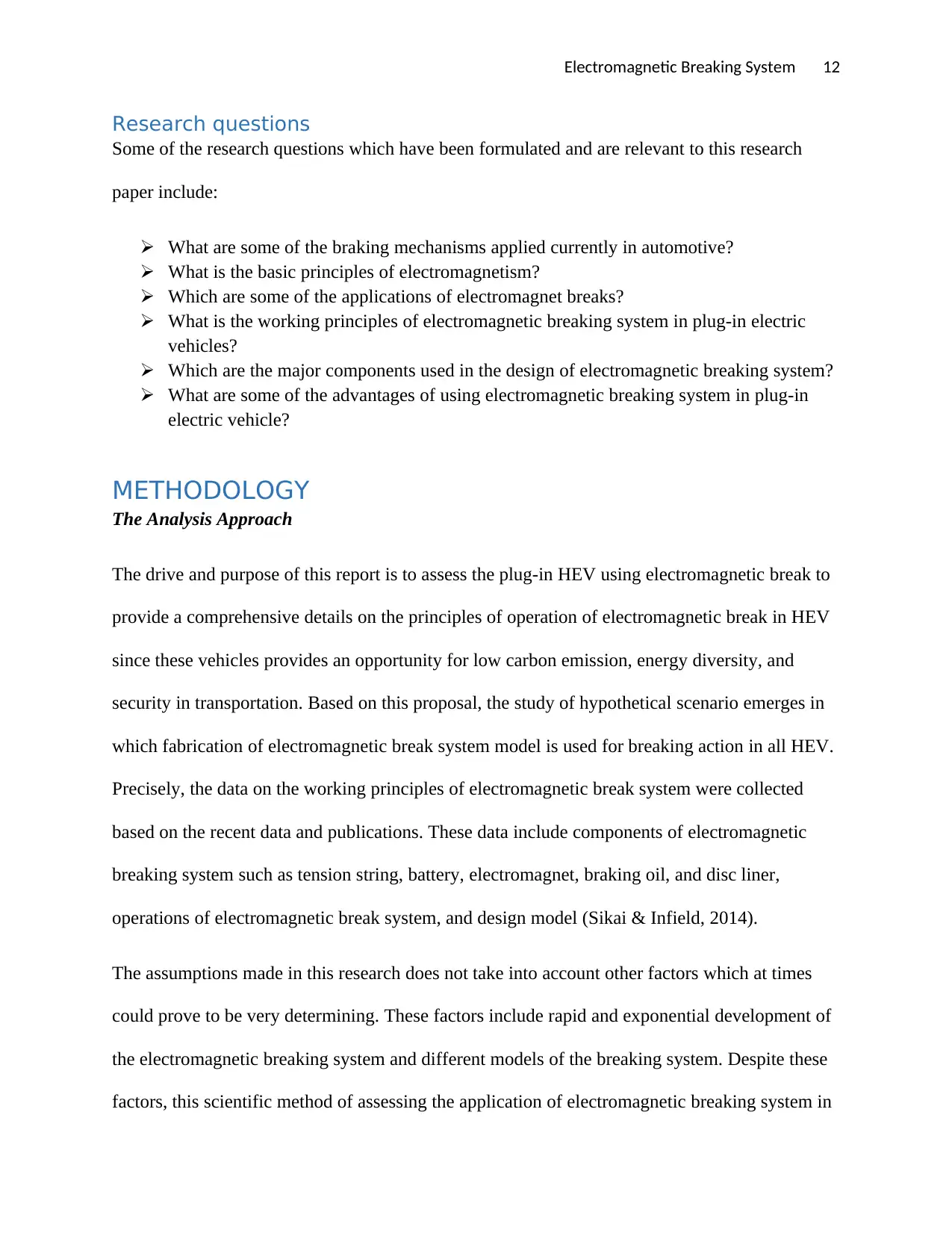
Electromagnetic Breaking System 12
Research questions
Some of the research questions which have been formulated and are relevant to this research
paper include:
What are some of the braking mechanisms applied currently in automotive?
What is the basic principles of electromagnetism?
Which are some of the applications of electromagnet breaks?
What is the working principles of electromagnetic breaking system in plug-in electric
vehicles?
Which are the major components used in the design of electromagnetic breaking system?
What are some of the advantages of using electromagnetic breaking system in plug-in
electric vehicle?
METHODOLOGY
The Analysis Approach
The drive and purpose of this report is to assess the plug-in HEV using electromagnetic break to
provide a comprehensive details on the principles of operation of electromagnetic break in HEV
since these vehicles provides an opportunity for low carbon emission, energy diversity, and
security in transportation. Based on this proposal, the study of hypothetical scenario emerges in
which fabrication of electromagnetic break system model is used for breaking action in all HEV.
Precisely, the data on the working principles of electromagnetic break system were collected
based on the recent data and publications. These data include components of electromagnetic
breaking system such as tension string, battery, electromagnet, braking oil, and disc liner,
operations of electromagnetic break system, and design model (Sikai & Infield, 2014).
The assumptions made in this research does not take into account other factors which at times
could prove to be very determining. These factors include rapid and exponential development of
the electromagnetic breaking system and different models of the breaking system. Despite these
factors, this scientific method of assessing the application of electromagnetic breaking system in
Research questions
Some of the research questions which have been formulated and are relevant to this research
paper include:
What are some of the braking mechanisms applied currently in automotive?
What is the basic principles of electromagnetism?
Which are some of the applications of electromagnet breaks?
What is the working principles of electromagnetic breaking system in plug-in electric
vehicles?
Which are the major components used in the design of electromagnetic breaking system?
What are some of the advantages of using electromagnetic breaking system in plug-in
electric vehicle?
METHODOLOGY
The Analysis Approach
The drive and purpose of this report is to assess the plug-in HEV using electromagnetic break to
provide a comprehensive details on the principles of operation of electromagnetic break in HEV
since these vehicles provides an opportunity for low carbon emission, energy diversity, and
security in transportation. Based on this proposal, the study of hypothetical scenario emerges in
which fabrication of electromagnetic break system model is used for breaking action in all HEV.
Precisely, the data on the working principles of electromagnetic break system were collected
based on the recent data and publications. These data include components of electromagnetic
breaking system such as tension string, battery, electromagnet, braking oil, and disc liner,
operations of electromagnetic break system, and design model (Sikai & Infield, 2014).
The assumptions made in this research does not take into account other factors which at times
could prove to be very determining. These factors include rapid and exponential development of
the electromagnetic breaking system and different models of the breaking system. Despite these
factors, this scientific method of assessing the application of electromagnetic breaking system in
⊘ This is a preview!⊘
Do you want full access?
Subscribe today to unlock all pages.

Trusted by 1+ million students worldwide
1 out of 18
Related Documents
Your All-in-One AI-Powered Toolkit for Academic Success.
+13062052269
info@desklib.com
Available 24*7 on WhatsApp / Email
![[object Object]](/_next/static/media/star-bottom.7253800d.svg)
Unlock your academic potential
Copyright © 2020–2025 A2Z Services. All Rights Reserved. Developed and managed by ZUCOL.





